As a young kid who spent his spare time flicking through the Melway street directory, there was a place on Phillip Island that always intrigued me – a suburb called ‘Summerlands’, and the mysterious “This area is subject to a Government acquisition program” note alongside.

Melway Edition 22 Map 431 (1993)
Paying a visit to Summerlands
It took me until 2011 to finally visit Summerlands in person.
The views were fantastic.
But all I found was a ghost town.
Gravel tracks leading into the scrub.
And a handful of abandoned houses.
Ready to be demolished.
So what happened?

Google Maps satellite imagery (2016)
A history of Summerlands
Subdivision of Summerlands commenced in the 1920s with 12 large allotments created, along with features such as a roundabout and cypress trees that were still visible decades later. Between 1927 and 1931, 227 new blocks were created, and from 1929 to 1940 there was a nine-hole golf course on what is now the Penguin Parade car park.

Photo from the Phillip Island and District Historical Society collection
In 1950s, a further 437 blocks were created, and the final subdivisions were carried out in 1958 and 1961 on land closer to The Nobbies. Much of the land was sold to speculators rather than those interested in building on it, and by 1974 only 11 percent of the 986 blocks of land had been cleared or built on.

Phillip Island Nature Parks photo
By the 1970s it was recognised that residential development of the estate would threaten the adjacent penguin colony, but it was not until 1985 that the Victorian Government launched the “Summerland Estate Buy-Back Programme” to purchase all 774 allotments on the Summerland Peninsula and add them to the Phillip Island Nature Park, with a projected end date of 2000. This decision meant that land owners could not build on their land, improve their properties, or sell them to anyone but the Government.
In the years that followed a total of 732 properties were been voluntarily sold by their owners, at a cost to the government of around a million dollars a year.

Phillip Island Nature Parks photo
With the final push made in 2007, when the decision was made to compulsorily acquire the final 42 properties – 20 empty blocks and 22 with houses, held by 34 private owners – over the next three years, at a cost of $15 million.

Bass Coast Planning Scheme – Public Acquisition Overlay at Summerlands Estate as of 23 May 2007
A tour of the last remaining houses
In February 2008 the Google Street View car did the rounds of Summerlands Estate, capturing the last remaining houses.
Classic 1950s fibro beach houses.
1970s brick.
Or looking to have been built just before the 1985 land buyback.
Some were out in the middle of an empty plain.
Others nestled between the tea trees.
Or hidden away completely.
Some looking to be only used at holiday time.
Others looking like they were occupied year round.
With neat front gardens.
But some had already been demolished.
And the end
In 2007-08 five property purchases were settled and agreement to purchase one property was reached, along with six negotiated purchase offers and one offer for compulsory acquisition. In 2008-09 fourteen properties were purchased taking the total number to 25, leaving 17 properties still to be acquired, a process completed in June 2010.

Land Victoria showing Summerlands Estate land still under separate titles as of 13 June 2011
At the time of my 2011 visit, the Summerlands Estate was being returned to nature.
The roads had been closed to vehicles.
Few houses remained.
Excavators at work clearing them away.
Leaving behind a front fence.
Gardens.
An empty block where houses once stood.
Building rubble.
Ready for new tree plantings.
Introduced trees has been ringbarked.
Slowly killing them.
Before their eventual removal.
Power lines were also being removed.
Replaced by new underground wires.
And farewell
I drove past the house on the hill in 2011.
By 2013 the only trace left was a plot of freshly planted trees.
I wonder how it looks a decade on.
Further reading
- Govt forces penguin reserve land buyback (ABC News, 2007)
- When Phillip Island penguins won, and land owners lost (ABC News, 2018)
- To Save Tiny Penguins, This Suburb Was Wiped Off the Map (New York Times, 2019)
- Summerlands Rehabilitation Project (Phillip Island Nature Parks, 2015)
- Department of Sustainability and Environment. “Annual Report 2008 – Report of Operations”
- Department of Sustainability and Environment. “Annual Report 2009 – Report of Operations”



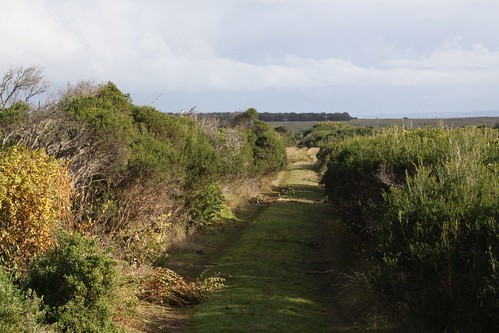
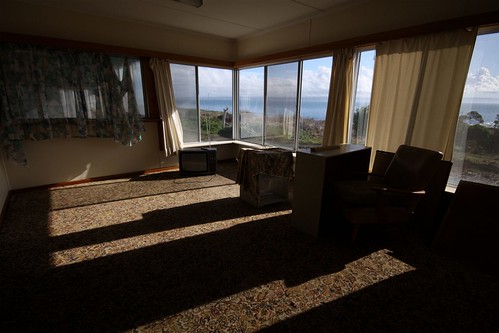
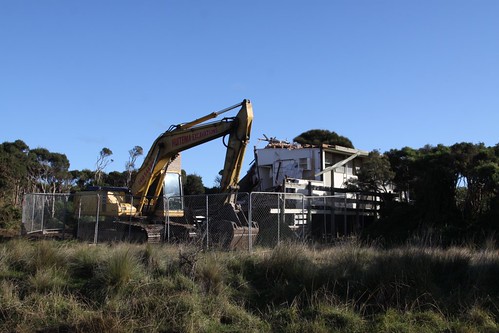


















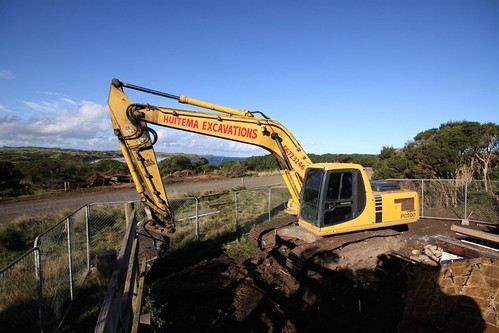
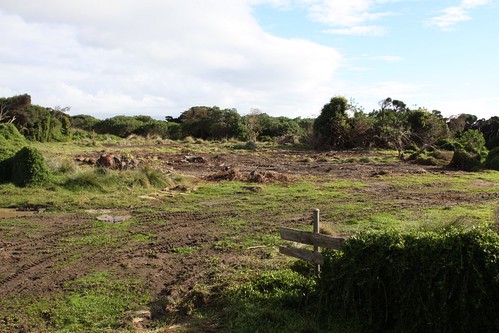


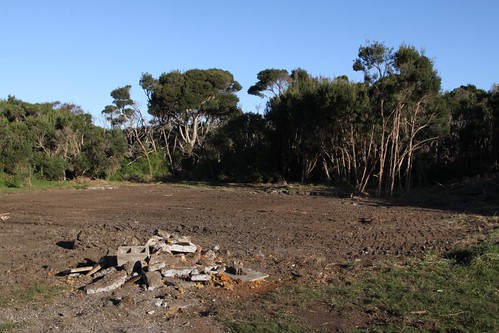


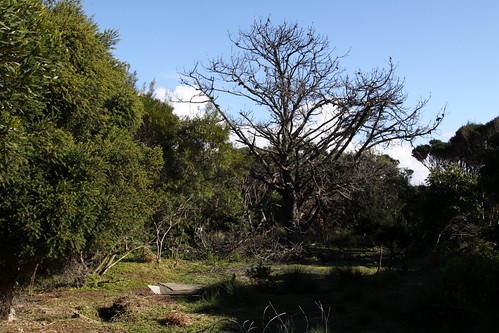

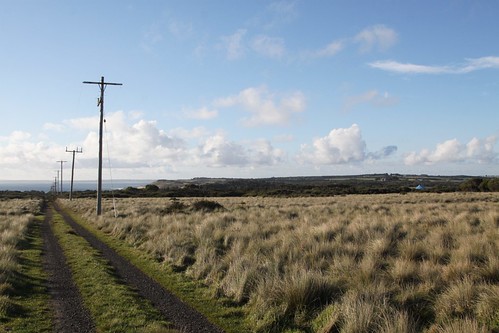
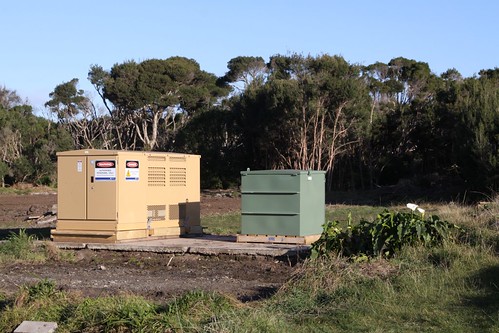
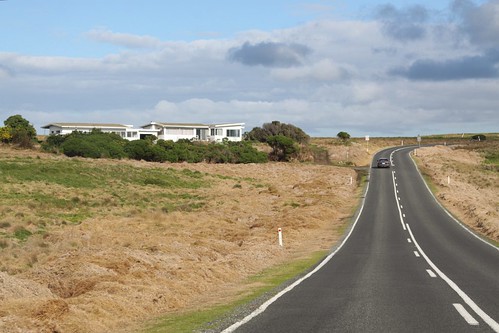


Finally getting around to turning a old photo collection into a detailed blog?
Yes indeed!
Our old house, sitting above Summerland Bay, was featured in a photo, uncaptioned but I think above the one marked ‘or hidden away’. We were compulsorily squired after a very drawn out and traumatic and emotionally draining time for those of us passionate about the area, the place and the wildlife. Our house had been built in the late 1940ies with three generations involved. When it was built there were only about 5 others there. I had been going there first to stay in the old guest house, immediately after World War 2, from the age of about 6 or 7.
The reason the Government spent $1 million a year in the beginning was that it was the full amount of the money allocated to the scheme, and despite many more people being prepared to relocate at the time, the money was capped. At the time there was one person providing the valuations, attached to the government, giving grossly inadequate valuations so that it was impossible to relocate to a similar position on the Island.
The whole buyback was entirely a necessary one and in the long term would have impacted negatively on the wild life however the process was extremely poor and cruel to those involved and ultimately dragging out over 25 years of limbo.
We were there every summer in the 1970s & a lot of weekends. We’d ride our bikes to the general store, on the dirt & gravel side roads & in the afternoons we’d swim at Summerland beach. My best friends family owned one of the homes at Summerland that was compulsory acquired. My parents home was compulsory acquired too. They got ripped off by the government. It was beyond stressful for all concerned.
Back in those days. We would sit quietly at night, and very still with a torch, while some of the little penguins would walk up & around us to go to their hole/burrows. The adults/grown ups were always there to supervise. This was on the beach by Cat Bay (and along the road going up to the Nobbies) and this was in summerlands. We were only a few blocks back from the beach. (Then again things look smaller when you go back as an adult).
I do remember some of the little penguins getting killed by cars on the side of the road. Which would upset us children.
We’d walk to the summerlands beach from the sandy car park and we’d see the little penguins in their holes waiting for their parents to come home at night. Nobody disturbed them back then, it was generally more locals and everyone appeared to respect their surroundings. That’s what we were taught as kids.
We were a few blocks back from Cat Bay. The holiday house was on stilts, like a lot of the holiday homes & permanent residents were back in the late 60s & early 70s. It was the older homes, in the area, that were built on the ground.
My friends house was still a relatively new home in the early 70s. The side of the house, where the lounge room was, looked up to the Nobbies track. It was exciting during a lightening storm, as it would light up the Nobbies track up the hill etc.
PI was a different place back then. It was the best part of my childhood. Absolutely without doubt, it was Phillip Island & Summerlands that were idyllic. Some of the kids needed that escape & others just had a great childhood. There was obviously less population & you’d see the surfers catching waves in the early morning (looking at a distance) at Cat Bay.
I reconnected with the place, as an adult around 2011 & took my husband to see the old home & the neighbourhood. My friends parents old home was actually still standing (surprisingly) but it had an awful feel about it. The whole place felt like a ghost town. Plus the house was ready for demolition as many of the homes in the area, that I remember, had already been demolished. The home & homes – had been compulsory acquired by the government some years back. I think there were one or two homes closer to the highway still hanging in there, with people living there, but it felt abandoned and the place had completely changed. It was like the whole area had been rubbed out. It was definitely like a ghost town. Whereas in the 60s it had been presented as an up & coming area. More choice of swimming surf beaches & the Nobbies etc. so it was a weird turn around in the eighties for the government to be doing compulsory acquisition.
Many of the holiday home residents had moved from other (older & more established) parts of the island to live in Summerland.
For many of us kids back then it was a wonderful memory, but became very stressful for the parents later on. Many of the families today still have holiday homes on PI in a different part of the island and those that were permanent residents have settled in other parts of Phillip island too. Then there were some that found the whole thing just so traumatic that they moved completely out of the area. Also important to note that what was paid for the compulsory acquisition and what the cost of re establishing one’s self elsewhere on the island didn’t marry up. This was unfortunately a very common situation with the government in the 70s & 80s around melbourne & Victoria not paying the correct value of the home. Then you find most residents that were relocating ended up out of the area or in a less socio-economic area, than what they had in the beginning. People had worked hard all their life and put their life savings into their homes. Sadly this is all to familiar to me.
To end on a positive note: Summerland back in those days of the late 60s & 70s was fantastic for children, families & singles to live an uncomplicated and joyful existence. The wildlife and the land around was well respected & enjoyed for its beauty & raw and often rugered appeal.
Fascinating, great article.
Thanks!
I can remember being fascinated with the Summerlands estate as a kid in the 80s and 90s due to also noticing that note in the Melways. In fact my interest in the estate was probably greater than my interest in the penguin parade at the time.
I can remember that there used to be special gates that closed off the roads into the estate at night for everyone except local residents because of concerns that cars would impact the penguins that nested in the area.
Unfortunately I didn’t carry a camera around with me back in those days!
Now that the estate is gone, at night time they now close off the entire stretch of Ventor Road towards The Nobbies.
https://www.google.com/maps/@-38.5059504,145.1466286,3a,73.9y,236.08h,92.55t/data=!3m6!1e1!3m4!1sbC1tO27Od1VPfYNfZQCj5g!2e0!7i3328!8i1664
We used to slowly drive around the estate in the evening penguin spotting. The gates mentioned above were installed after hoons thought it was a great area to tear around and penguins were injured and killed. While I expect it is closed at night, last year The Boulevard was still open during the day at least.
There’s only one, and it’s called ‘Summerland’.
Not sure why you’ve renamed it.
Both are correct:
https://maps.land.vic.gov.au/lassi/VicnamesUI.jsp?placeId=102862
For some reason the plural ‘Summerlands’ is the name of the suburb, but everything else is singular – Summerland Estate, Summerland Bay, and Summerland Peninsula.
Dear Marcus, your comment that the Ventnor Road has been cut off isn’t entirely true. The road is open to the Nobbies where there are walks and tourist facilities and exhibits, and to the beaches on the side along that peninsula, however, there is a curfew and from evening it is blocked off as visitors go to view the penguin parade.
Some poor wording on my part – you’re 100% correct. 🙂
One flaw in the reporting: not “adjacent penguin colony”, the WHOLE of Summerlands was the last remaining habitat of penguins after 8 of the 9 other colonies on the island were wiped out due to development. The motivation for this buy back was driven by conservationists tracking penguin deaths and extrapolating figures from consistent decline in numbers meaning without action penguins on PI would be non-existent by mid 90s. Pretty essential detail and very important conservation messaging around human impact on nature… surprised reporter neglected to even touch that… Could have been a great opportunity for environmental learning and inspiration for the good that can be done for wildlife if humans are less entitled to land.
Also, they are not “empty plains,” the Summerland “plains” are home to 33,000 Little Penguins now, thanks only to the work of those conservationist (thats approx 18,000 burrows most of which are difficult to identify unless u know what you’re looking for, which means they are now endangered by tourists trampling though these “empty plains” and crushing their eggs, collapsing their burrows and terrorising their chicks). Awareness of environment is important.
Thanks for the extra detail about the penguin’s habitat – it was something I’d missed.
As for the penguin colonies that no longer exist, I found this 1992 paper by Peter Dann that goes into further detail:
https://www.researchgate.net/publication/258567392_Distribution_Population_Trends_and_Factors_Influencing_the_Population_Size_of_Little_Penguins_Eudyptula_minor_on_Phillip_Island_Victoria
With this map showing the former penguin colonies, and the last sighting date:
The days show the decline was definitely linked to the development of Phillip Island, although the 1930s extinctions on the south coast don’t align with current townships.
– Red Point, Cape Woolamai – 1880
– Red Rocks – 1897
– Cowes Yacht Club – c1920
– Kitty Miller Bay – 1935
– Berry’s Beach – 1935
– Grossard Point – 1967
– Point adjacent to Pyramid Rock – 1972
– Smith’s Beach – 1978
– Woolshed Bight – 1980
Interesting map of ‘former’ penguin colonies. Some of these areas are once again supporting penguins and during summer increasing numbers of tourists are sitting on the beaches for a free viewing.
That’s good news that the penguin population is starting to grow again.
Speaking of flaws in reporting Aimee, not sure how many penguins were killed by humans with access to land on Summerlands estate. The residents of Summerland estate respected and loved living with the penguins and you will find that foxes and non residential traffic at night was the greatest risk although domestic pets from other parts of the island did also have an impact. The fox problem was so serious in the late 80’s that a fox proof fence was installed which cut returning penguins off from their chicks on the summerland peninsula. I assume the experts thought this collateral damage was worth it..but you paint a really lovely picture of conservation and I’m sure the income of the penguin parade was not a motivator whatsoever and that bright lights and flash photography from paying tourists is a great example of human impact on nature and putting nature first.
[…] Summerlands Estate on Phillip Island […]
[…] discovered Summerlands Estate of Phillip Island and the mysterious “This area is subject to a Government acquisition program” note alongside as […]
[…] Once the site of Summerlands Estate. […]
[…] headed out to Phillip Island, to look for the remains of the Summerland Estate. The only trace – a few dirt […]
In year 12 1988, one of my Geography case studies was Summerlands. I found it educational then but even more fascinating now – 35 years on! Great article Marcus.
Thanks Rob!